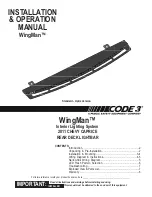
5. Once you repair or replace the original road tire and
reinstall it on the vehicle in place of the compact spare or
non-matching full size, the TPMS will update automati-
cally. In addition, the “TPMS Telltale Light” will turn off
and the graphic in the instrument cluster will display a
new pressure value instead of dashes (- -), as long as no
tire pressure is below the low-pressure warning limit in
any of the four active road tires. The vehicle may need to
be driven for up to 20 minutes above 15 mph (24 km/h)
in order for the TPMS to receive this information.
TPMS Deactivation — If Equipped
The TPMS can be deactivated if replacing all four wheel
and tire assemblies (road tires) with wheel and tire assem-
blies that do not have TPMS Sensors, such as when
installing winter wheel and tire assemblies on your vehicle.
To deactivate the TPMS, first replace all four wheel and tire
assemblies (road tires) with tires not equipped with Tire
Pressure Monitoring (TPM) Sensors. Then, drive the ve-
hicle for 20 minutes above 15 mph (24 km/h). The TPMS
will chime, the
⬙
TPM Telltale Light
⬙
will flash on and off for
75 seconds and then remain on. The instrument cluster will
display the “Service Tire Pressure System” message and
then display dashes (--) in place of the pressure values.
Beginning with the next ignition cycle, the TPMS will no
longer chime or display the “Service Tire Pressure System”
message in the instrument cluster but dashes (--) will
remain in place of the pressure values.
To reactivate the TPMS, replace all four wheel and tire
assemblies (road tires) with tires equipped with TPM
sensors. Then, drive the vehicle for up to 20 minutes above
15 mph (24 km/h). The TPMS will chime, the
⬙
TPM Telltale
Light
⬙
will flash on and off for 75 seconds and then turn off.
The instrument cluster will display the “Service Tire Pres-
sure System” message and then display pressure values in
place of the dashes. On the next ignition cycle the
⬙
Service
Tire Pressure System
⬙
message will no longer be displayed
as long as no system fault exists.
General Information
The following regulatory statement applies to all radio
frequency (RF) devices equipped in this vehicle:
This device complies with Part 15 of the FCC Rules and
with Industry Canada license-exempt RSS standard(s).
Operation is subject to the following two conditions:
(1) This device may not cause harmful interference, and
(2) This device must accept any interference received,
including interference that may cause undesired operation.
5
SAFETY
167
Summary of Contents for 300 2018
Page 4: ......
Page 11: ...REAR VIEW Rear View 1 Rear Lights 2 Trunk 2 GRAPHICAL TABLE OF CONTENTS 9 ...
Page 14: ......
Page 85: ...Operating Tips Chart 3 GETTING TO KNOW YOUR VEHICLE 83 ...
Page 116: ......
Page 142: ......
Page 214: ......
Page 250: ...Distance Setting 3 Bars Long Distance Setting 2 Bars Medium 248 STARTING AND OPERATING ...
Page 265: ...Slow Tone Solid Arc Fast Tone Flashing Arc 6 STARTING AND OPERATING 263 ...
Page 269: ...Fast Tone Flashing Arc Continuous Tone Flashing Arc 6 STARTING AND OPERATING 267 ...
Page 296: ......
Page 340: ......
Page 400: ......
Page 460: ......
Page 467: ...INDEX 12 ...
















































